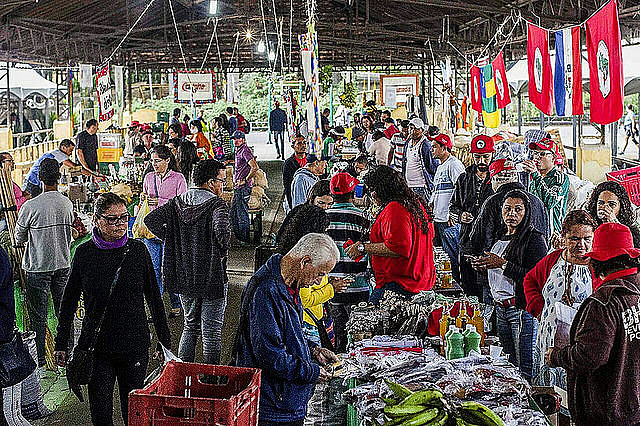The 3rd National Agrarian Reform fair, organized by the Landless Workers’ Movement (Movimento dos Trabalhadores Rurais Sem Terra – MST), is taking place in São Paulo and sells three different types of food products: agroecological, organic, and in transition. But what’s the difference between each of these different categories?
It is not just about the characteristics of the final product, but also about the way each step of the production process is organized, from choosing the place to start a crop to the seeds and the working conditions of rural workers.
Organic
In Brazil, the only requirement to have organic products is to grow them without agrochemicals. This system does not take into consideration the working conditions of farmers, how compatible the crop is with the local ecosystem, and the level of industrialization throughout the production process.
This means that organic food, although healthier than large-scale agribusiness production, does not have the same level of social and environmental responsibility as the agroecology movement advocated by the MST.
Agroecology
“Agroecological products, the kind of production system we advocate in the Landless Movement, is different right from the start,” Milton Fornazieri from the Production Sector of the MST explains. “Every agroecological product is certified by both traditional certifiers, such as the Institute of Marketecology [IMO], and community certification, which is done by organizations from the place where they are produced,” he adds.
Some of the legal requirements for certification according to Brazilian law include having a food production chain that is free of deliberate contamination (agrochemicals); protects the biological diversity of the ecosystems where the production system is; promotes the healthy use of soil, water, and air; and recycles organic waste, reducing as much as possible the use of non-renewable resources.
The MST settlements that are considered in transition are preparing their operations to transition from a production system that is similar to industrial agribusiness into organic, and from organic into an agroecological production system.
Ecosystem
One of the main differences between an organic and agroecological seal is the human factor: the former has been incorporated by capitalist agribusiness, and can even be produced in large estates with almost completely mechanized crops, and with few or no rural workers involved, as this system is based on food processing centers.
On the other hand, agroecology promotes pre-industrial farming techniques that are still used in small family farms and are less harmful to ecosystems, combining them with modern scientific knowledge to make sure good soil and water conditions and the habits and needs of the local fauna are respected.
For example, crop rotation in agroecology is based on the eating habits of the small farmers who grow them, and not on big farmers' financial plans. This process creates a more diversified production and helps to replenish nutrients in the soil.
“Agribusiness farmers claim they have the conditions to solve the problem of chemicals in agriculture, but we believe that is not true. Only those who are in the countryside every day, in small farms, in agrarian reform land, know how to grow agroecological products. It’s not a tractor or a machine that makes agroecology. It’s about the relationship with the land, and about giving the land what it needs,” Fornazieri explains.
Prices
Large-scale agribusiness has also taken advantage of the huge public debate around healthy food as a way to increase its profit margins – even though organic production is different from traditional agribusiness practices, organic products do not need to be more expensive. Agrarian reform settlements, for example, make an effort to balance their costs and still offer consumers fair prices.
“There is a lot of misinformation about how much organic and agroecological products cost. Those who are doing it to make a profit think that they can charge more and take advantage of consumers just because they grow organic food. We are engaged in a big debate to have fair prices both for producers and consumers. If costs increase compared to the traditional agribusiness system, there can’t be an exploitation process like the one these large organic estates across Brazil are doing,” Fornazieri said.




